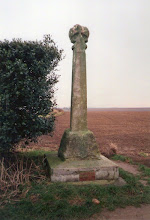I am pleased to report that my 6mm Great War project that I started back in
July 2014, has finally got off the blocks. After months of (occasional) painting and gathering terrain, I finally played my first game of Great War Spearhead II last weekend.
I thought it best to start with a simple scenario so I chose
Rolling with the Punches - one of Robin Sutton's excellent GWSH II introductory scenarios from his
Great Adventure site. This scenario has a small BEF force seeking to delay a German advanced guard during the Great Retreat of August and September 1914.
This gave me the first opportunity to try out my MDF hex terrain. This is a no frills version of the very effective method of using
Hexon terrain to build up contours under a terrain mat employed by
Robert Dunlop. Alas shipping Hexon terrain to the Antipodes costs more in postage than it cost me to buy this magnificent collection (and you see only a portion of it here) of hand cut (!!!) MDF hexes. I obtained these as a bit of a one off from a local supplier (thanks Mike!). Not that the postage cost is the fault of Kallistra, just a fact of geography!
 |
| Hills are laid out in preparation for the felt cloth |
 |
| I ironed around the hills to improve definition of the contours through the felt. |
The aim of this scenario is for this detachment of the British Expeditionary Force (BEF) to hold the bridge for 6 turns to allow the remaining elements (not depicted) of the BEF to secure a defensive position further south. I was playing solo so to add a level of surprise, I set up he BEF and provided four possible lines of attack for the Germans all of which culminated at the bridge.
 |
| The Germans took the initiative but drew the furthest entry point from the bridge. They approach in a series of columns while the BEF defends a perimeter in front of the bridge. British artillery lined the far side of the river near the village and their HQ. |
 |
| The BEF were under 'defend' orders so had to sight the Germans before they could adjust their deployment. |
 |
| German infantry are sighted as they advance up the valley. The German commander orders a regiment of 77mm field guns to deploy on the nearby hill (middle left) |
 |
| On a tight schedule, the Germans surge forward into small arms range. |
 |
| Small arms fire takes its toll on the German left while a battery of British 18 pdrs open fire. |
 |
Finally, German field gun regiment lays down a barrage on the British centre hoping to punch a hole through which the advance can continue. Despite the fury of the barrage, the Old Contemptibles stood their ground. At this stage I realised the 6 turns given to the Germans was unrealistic given their distant entry point and decided to extend the time
available to 8 turns. |
 |
| As the volume of fire increased, companies of infantry were being mown down (destroyed companies marked with white skulls on red bases) on both sides and those remaining troops were largely suppressed (white skull) |
 |
| Turn 8: The German advance has stalled. The BEF have paid a heavy price but the order is given to fall back as the main body is now well on its way to the next defensive position. The BEF live to fight another day. |
I really enjoyed this first touch of the GWSH II rules. I'm sure I made many mistakes but time and rereading in the light of this experience will sort that out.
I know I've got a long way to go towards learning the intricacies of industrial warfare. The overwhelming feeling from this game was that of blundering into contact, with the Germans driven to accept heavy losses to keep to their tight timetable. Not unlike the events of 1914!






















































